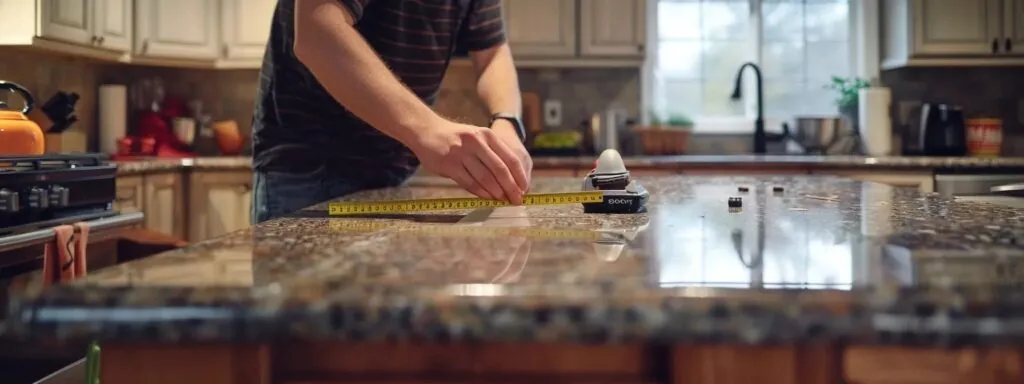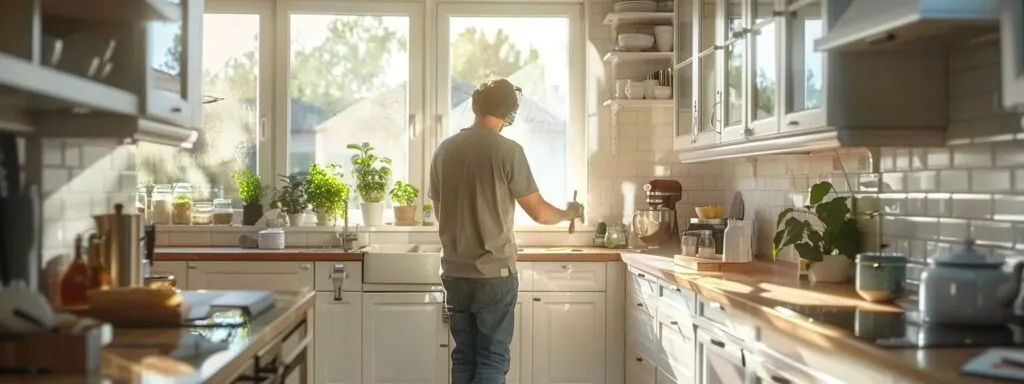Starting a kitchen remodel can be both exciting and overwhelming. If you are wondering where to start, you are not alone. It is easy to get caught up in the endless possibilities and lose sight of the essential first steps. Getting started on the right foot is critical for any home remodeling project. However, with so many aspects and components to consider for the kitchen, it can be overwhelming to get started at times.
This article will break down the process into manageable steps, ensuring you are well-prepared to tackle each stage of your kitchen transformation. By following our tips and advice, you will be on your way to creating a beautiful and functional space that reflects your taste and enhances your daily life.
Essential Key Takeaways for Your Kitchen Remodel Success

● Set Clear Goals: Define your kitchen remodel goals by distinguishing between needs (functionality) and wants (aesthetic upgrades). Prioritizing functionality over aesthetics ensures the kitchen meets your lifestyle requirements.
● Plan a Realistic Budget: Establish a budget based on estimated costs and allocate funds for unexpected expenses. Knowing where to splurge (e.g., appliances, cabinetry) and where to save (e.g., lighting, backsplashes) can help manage costs.
● Decide on DIY or Hiring Contractors: Choose between hiring a general contractor, kitchen designer, or doing parts of the remodel yourself based on the complexity of the project, your skill set, and budget.
● Follow a Step-by-Step Remodeling Process: Start with planning and design, move to demolition, plumbing, and electrical work, and finish with cosmetic elements like painting, cabinetry, and final touches.
● Set Realistic Expectations: Understand that challenges like structural issues or delays can arise. Staying flexible and focusing on priorities will help keep the project on track.
1. Set Your Kitchen Remodel Goals

Before embarking on a kitchen remodel, it is essential to establish clear goals. Understanding your needs and wants will guide every decision, from layout changes to design elements. A kitchen remodel is more than just upgrading aesthetics; it is about creating a space that suits your lifestyle. There are also different types, so it’s essential to know what you want first.
By identifying your priorities early on, you will ensure the remodel meets your functional and aesthetic requirements. Let’s explore some key aspects when setting your kitchen remodel goals.
Identifying Your Needs and Wants
Start by determining what you need versus what you want in your kitchen. Needs are essential—consider improving storage, upgrading old appliances, or maximizing counter space. Wants, on the other hand, are the aesthetic or luxury upgrades, like high-end finishes or modern lighting. Take a close look at how you use your kitchen daily and make a list of must-haves and nice-to-haves. This distinction helps you focus on essential improvements first while keeping your desired features in mind. Overlooking this and ignoring the tough questions can cost you time and money down the road so it is always best to look honestly at wants and needs.
Prioritizing Functionality Over Aesthetics
While it’s tempting to focus on the look of your kitchen, functionality should always come first. A beautiful kitchen means little if it does not work well for your daily routines. Consider how you move through the space, how much storage you need, and how accessible everything is. For example, an open layout might look stunning, but it will not be practical if it compromises storage or counter space. Think about the flow of your kitchen and how it fits your cooking and dining habits. Design a kitchen that works for you and your family and that will be a blessing and benefit to you and make your lives easier.
Setting Realistic Expectations for Your Remodel
Setting realistic expectations is crucial to a successful remodel. Many homeowners start with grand visions, but it’s vital to balance your dream with practical considerations like time, budget, and the limitations of your current space. Understand that unexpected challenges, such as structural issues or material delays, can arise. Stay flexible and focus on your top priorities to avoid disappointment. Setting a clear budget and knowing what is achievable within your space will keep the project on track. Being realistic with expectations will also ensure you are not disappointed by expecting something that is not feasible or attainable in the end.
2. Plan Your Home Improvement Budget

Setting a budget is one of the most critical steps in a kitchen remodel. Proper financial planning will help guide your decisions, prevent overspending, and ensure a smooth remodeling. Whether working with a small or large budget, understanding where your money will go is essential. Let’s explore critical strategies to help you create a budget that works for your remodel.
Estimating Costs and Setting a Budget
Start by getting a clear picture of the overall costs associated with your kitchen remodel. Research the typical kitchen cabinets, appliances, countertops, flooring, and labor costs in your area. Gathering quotes from contractors or using online tools for estimates is helpful. Once you know the average costs, set a realistic budget that aligns with your financial situation. Sticking to this budget as you move forward is essential, making adjustments as needed.
When it comes to planning a kitchen remodel, setting a realistic budget is crucial to ensure that your project stays on track and within your financial means. The cost of a kitchen remodel can vary widely depending on the scope of work, quality of materials, and your location. On average, a mid-range kitchen remodel can cost anywhere from $15,000 to $30,000, while a high-end remodel can surpass $50,000 or more.
Allocating Funds for Unexpected Expenses
Unexpected expenses are a standard part of any remodel, so allocating funds for contingencies is essential. Industry experts recommend setting aside at least 10% to 20% of your budget for unforeseen costs. Issues such as plumbing problems, structural damage, or material delays can quickly add up. This foresight ensures that your remodel stays on track even when the unexpected occurs, reducing stress and keeping the project moving forward smoothly.
Determining Where to Splurge and Where to Save
A well-planned budget includes knowing where to splurge and where to save. For example, investing in high-quality, durable appliances or cabinetry can add long-term value to your kitchen. On the other hand, you can save on items like lighting fixtures or backsplashes without sacrificing style. Focus on areas that will enhance the functionality and longevity of your kitchen, and scale back on elements that have less impact on your daily use.
Related Post: Tips for Your Kitchen Renovation Project
3. Decide Whether to Hire a Kitchen Remodeling Contractor or DIY

One of the big decisions you’ll face during a kitchen remodel is hiring professionals or tackling some of the work yourself. Each option has its benefits, but the choice depends on your budget, skills, and project scope. Let’s look at the advantages of working with a kitchen designer or general contractor and the areas you can confidently handle as a DIYer.
Benefits of Working with a Kitchen Designer
Hiring a kitchen designer can be a game-changer for your remodel. Designers bring expertise in creating functional kitchen layouts, maximizing space, and ensuring a cohesive look. They stay current on the latest trends and materials, offering creative solutions you might not have considered. Their experience ensures that every aspect of your kitchen works together, from cabinetry and appliances to lighting and storage. While it’s an additional expense, a designer often saves you money in the long run by preventing costly mistakes.
When to Consider a General Contractor
A general contractor is essential if your kitchen remodel involves significant structural changes, electrical or plumbing work, or large-scale installations. Contractors manage the entire process, from permits and materials to coordinating subcontractors. They ensure everything meets building codes and safety standards, giving you peace of mind. Hiring a contractor is an intelligent choice if your project is complex or requires specialized skills. While it adds to the overall cost, the expertise and efficiency they provide help keep your project on schedule.
DIY Aspects of Kitchen Remodeling
For those who enjoy hands-on work, there are certain aspects of a kitchen remodel you can tackle yourself. DIY projects like painting, installing hardware, or assembling cabinetry can help you save on labor costs. If you’re confident with tools, you might also handle tasks like tiling backsplashes or laying flooring. However, it’s essential to know your limits and avoid taking on work that requires specialized skills, such as electrical or plumbing jobs. Taking on manageable DIY tasks can be a rewarding and budget-friendly option for some remodel aspects.
4. Following a Proper Kitchen Remodeling Process

To ensure a smooth and well-organized process, it is essential to follow a strategic sequence of steps. The first and most crucial step in remodeling a kitchen is careful planning and design. This involves creating a layout, selecting materials, and determining a budget. Once the design plan is in place, the next step is to start with any demolition work that may be required, such as removing old cabinets, countertops, or flooring.
Following demolition, the focus shifts to any necessary plumbing and electrical work. This includes installing new plumbing fixtures, rewiring for lighting, and adding any additional outlets or switches. With the infrastructure in place, the next step is to install new drywall, flooring, and paint the walls. After the cosmetic elements are in place, cabinets and countertops can be installed, followed by appliances and fixtures. Finally, the finishing touches, such as backsplashes, lighting fixtures, and hardware, can be added to complete the look of the newly remodeled kitchen. By following this systematic order of remodeling, you can ensure a successful and efficient renovation project that meets your needs and vision for your kitchen space.
Conclusion
Remodeling your kitchen can seem like a big challenge, but with proper planning and clear goals, it can become an exciting journey. By understanding where to start a kitchen remodel, setting a realistic budget, and deciding whether to hire professionals or tackle DIY tasks, you’ll be on your way to creating the kitchen of your dreams.
Remember to prioritize functionality, set achievable expectations, and enjoy the process. With the right approach, your new kitchen will meet your needs and become a space you’ll love for years to come.
FAQs
1. What are the most common mistakes homeowners make during a kitchen remodel?
Mistakes such as underestimating costs, neglecting ventilation, or failing to account for workflow in the kitchen design often occur during remodels.
2. How can I maximize storage space in my kitchen remodel?
Specific strategies for maximizing storage, such as using vertical space, pull-out shelves, or custom cabinetry solutions, can greatly enhance kitchen functionality.
3. What kitchen trends should I consider for my remodel?
Current kitchen design trends like smart appliances, sustainable materials, or open shelving could influence your decisions for a modern and stylish kitchen.
4. How can I ensure my kitchen remodel increases my home’s resale value?
Choosing timeless designs, high-quality materials, and incorporating features that appeal to potential buyers can help boost resale value.
5. What are some eco-friendly options for a kitchen remodel?
Sustainable or eco-friendly choices like energy-efficient appliances, recycled materials, or non-toxic paints can make your kitchen more environmentally friendly.
6. How do I deal with disruptions during a kitchen remodel?
Managing living without a fully functional kitchen, such as setting up a temporary kitchen or planning meals in advance, can ease the stress during renovation.




